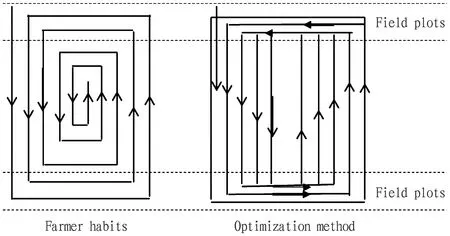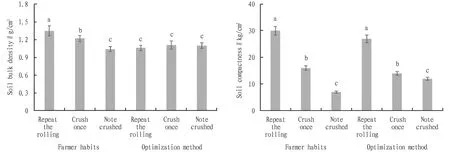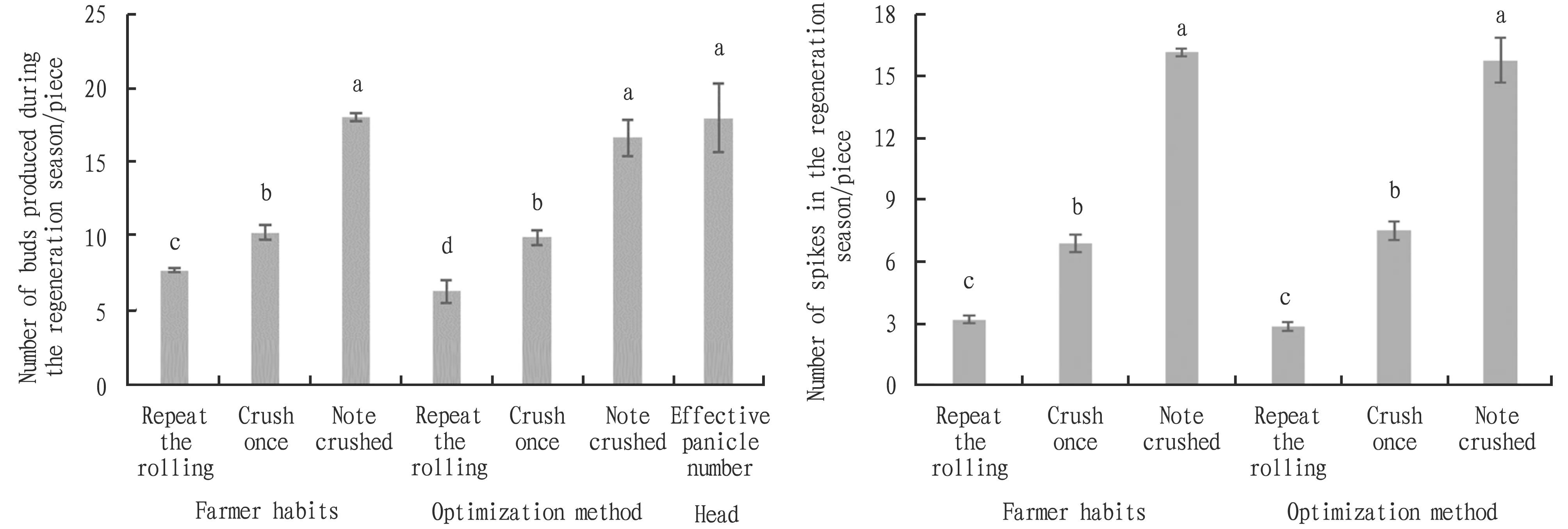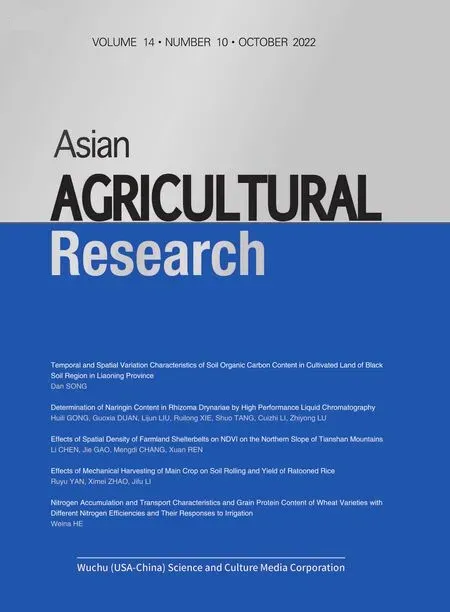Effects of Mechanical Harvesting of Main Crop on Soil Rolling and Yield of Ratooned Rice
2022-11-28RuyuYANXimeiZHAOJifuLI
Ruyu YAN, Ximei ZHAO, Jifu LI
College of Agriculture, Yangtze University, Jingzhou 434025, China
Abstract [Objectives]To study the effect of mechanical harvesting of main crop on soil rolling and yield of ratooned rice.[Methods]In this study, the harvesting method was optimized and improved through field research and theoretical research.[Results]Compared with farmers' habits, the mechanical harvesting method could significantly increase the working area per unit time and reduce the rolling area in the field, but it would increase the rolling rate of the land or transfer area.At the same time, the optimization method could reduce the soil bulk density in the primary rolling area, but it had no significant impact on soil compactness.[Conclusions]Compared with the farmer's customary method, the optimization method could reduce the crushing and damage of rice piles in the field, increase the seedling rate and panicle extraction rate, thus increasing the yield of rice in the ratooning season.
Key words Ratooned rice, Mechanical harvesting, Rice pile crushing, Production, Optimization method
1 Introduction
Ratooned rice is harvested in the first season of the medium rice varieties with strong tillering power, only two thirds of the above-ground plants are cut off, and the dormant buds that survive on the rice pile are given suitable water, temperature, light and nutrient conditions to germinate and regenerate, and then the ears are matured into a planting mode of rice in another season[1-2].Ratooned rice has the advantages of seed saving, labor saving, water saving, full use of light and temperature resources, low production cost and high efficiency, and has developed rapidly in the rice cultivation area of the Yangtze River Basin and has been generally valued by farmers.Rice harvesting has been developed from traditional manual harvesting and mechanical threshing to whole-feed crawler harvester harvesting, so as to achieve all aspects of crop harvesting, threshing, separation, sorting and grain collection[3-5].The widespread use of combined harvesters plays an important role in reducing agricultural labor intensity and improving the comprehensive efficiency of rice cultivation, so whole-feed crawler combined harvesters are also used for mechanical harvesting in the ratooned rice heading season and ratooning season[6-7].However, in the field operation of the combined harvester in the first season, the tires and tracks on the soil and rice pile inevitably crushed the soil and rice pile, resulting in the increase of soil density and the loss of rice pile to varying degrees.
Studies have shown that long-term mechanical compaction can cause soil porosity and water content to decrease, resulting in changes in soil physical structure and reduced nutrient effectiveness, which is not conducive to crop growth.Especially in the first season of mechanical harvesting, due to factors such as the weight of agricultural machinery, the moisture status of the field and the habits of drivers, the crushing rate of rice piles is extremely high, which in turn leads to mechanical damage to regenerated buds and a significant reduction in the germination rate, ultimately affecting the yield and quality of rice in the ratooning season[8-10].Based on a large number of field surveys, this study optimized and improved the operation mode in view of the practical problems of the habitual mechanical harvesting method(ring plot from outside, low efficiency and high crushing rate)commonly used by farmers.Under the premise of ensuring the operation efficiency, the optimization operation reduced the crushing of rice piles, thereby improving the germination rate and panicle extraction rate of ratooning buds, increasing the yield of the ratooning season, and providing a reference for the development of the ratooned rice industry.
2 Materials and methods
2.1 Overview of the test siteThe field test site is located in Jinsui Family Farm, Guanyindang Town, Shashi District, Jingzhou City, with convenient irrigation conditions during the rice season, which is conducive to ratooned rice production, and the planting scale reaches 150 ha.Before the test, the basic physicochemical properties of the tillage soil were as follows: pH of 6.24, organic matter content of 22.4 g/kg, available nitrogen content of 125.8 mg/kg, available phosphorus content of 13.7 mg/kg and available potassium content of 143.6 mg/kg.
The ratooned rice variety, Fengliang Youxiang No.1, was selected and bred by Hefei Fengle Seed Industry Co., Ltd.and was the indica type two-line hybrid rice.The first crop of rice was sown on March 28, machine-planted on April 25, and mechanically harvested on August 20; the ratooning began on September 10, and ratooned rice was gathered on September 12, and was harvested on November 13.
The combined harvesting machine for test is a Kubota grain combined harvester widely used in the region, with machine type of 4LZ-2.5, calibration power of 49.2 kW, a tool length of 4.8 m, a width of 2.3 m, a net width of 2.0 m, a track ground length of 1.7 m, a track gauge of 1.2 m, a track width of 0.4 m and a grounding pressure of 20.3 KPa, and operating productivity of 0.28-0.61 ha/h.
2.2 Experimental designThere were two treatments for the mechanical harvesting method of the first cropping rice, namely(i)the farmer’s conventional harvesting and walking mode and(ii)the optimization of the route harvesting walking method.Farmers were accustomed to harvesting and walking in the form of ring plots from the outside to the inside; the optimization route harvesting and walking method was the longitudinal equidistant walking ring shrinking mechanical harvesting method, and after 2-3 turns of the ring plot, the longitudinal walking harvest along the plot was mainly used.The specific walking routes are shown in Fig.1, with 3 repetitions, and other field management measures were consistent with local farmers.Since mechanical turning, harvesting, and rice transfer could form repeated rolling areas, primary rolling areas and unrolled areas in the field, field surveys were also carried out for these three areas.

Fig.1 Design of mechanical harvest route for first-cropping rice
2.3 Field surveys and measurements
2.3.1Mechanical harvesting efficiency and rolling rate.After the first crop of rice matured, the plot with moderate size, flatness and moisture status in the field was selected as the test area.The harvest time and the area of the field were recorded according to different treatments.At the same time, the rolling situation of the experimental field was followed up and investigated, and the actual crushing area and crushing rate were estimated.
2.3.2Soil bulk density and compactness.After the harvest of the first crop of rice, the soil bulk density of the cultivated layer in the repeatedly rolled area, the primary rolled area in the field and the unrolled area of each treated area was determined by the ring knife method.Soil compactness was determined by TJSD-750 soil compactness meter[3,11].
2.3.3Germination and panicle extraction in the ratooning season.After the harvest of the first crop of rice, each treatment set the repeated crushing area of the ground, the primary crushing area of the field and the non-crushing area, and 30 piles of rice were selected to track and investigate the germination and panicle extraction of the ratooned rice, and the extraction rate and panicle extraction rate were calculated.
2.3.4Yield and yield components of the ratooning season.One day before harvest of ratooned rice, 5.0 m×10.0 m sample was collected for each treatment, and the yield components such as the effective number of panicles, the number of grains per panicle and the weight of 1 000 grains of ratooned rice in the crushed and non-compacted areas were investigated.
2.4 Data processingMS Excel 2019 was used for data processing and plotting, Origin Pro 2020b software was used for statistical analysis of variance, andLSDmethod was used for analysis of significant differences atP<0.05 level.
3 Results and analysis
3.1 Effect of mechanical harvesting on operational efficiency and field rollingThe results of Table 1 showed that the farmers’ habitual mechanical harvesting method was more balanced on the field and the ground, but the overall crushing rate was high; the optimized mechanical harvesting method was heavier on the ground, which was 40.6% higher than the method by farmers.The field rolling width and field rolling rate of the optimized method were 0.28 m and 20.1% lower than that by farmers, respectively.Overall, head crushing accounted for only a small fraction of the mechanical rolling of the plot and the ratooning season yield was mainly contributed by the middle area of the plot.Therefore, the overall crushing rate of the optimized mechanical harvesting scheme was lower than that by farmers who were accustomed to mechanical harvesting.In addition, the harvesting operation efficiency results showed that compared with the farmers’ habitual harvesting method, the optimization method could significantly improve the efficiency of mechanical operation and increase the working area per unit time.

Table 1 Effects of mechanical harvesting on operational efficiency and field rolling
3.2 Effects of mechanical harvesting on soil bulk density and compactnessFrom the results of Fig.2, it can be seen that the change trend of soil bulk density in paddy field was manifested as follows: the repeated rolling area>the primary rolling area>the unrolled area, indicating that the greater the degree of mechanical compaction, the greater the soil bulk density.The harvesting and walking modes of each treatment machine had no significant effect on the bulk density of the soil in the unrolled area, and the soil volumetric weight was about 1.0 g/cm3.The soil bulk density in the primary and repeated rolling areas was 13.7% and 30.3% significantly lower than that by farmers, respectively.Similarly, for soil compaction, neither harvesting method had an effect on the unrolled area.The soil compactness of the primary and repeated rolling areas treated by the optimized method was lower than that by farmers, and it was manifested as follows: the repeated rolling area>primary crushing area.

Fig.2 Effects of mechanical harvesting on soil bulk density and compactness
3.3 Effects of mechanical harvesting on budding and panicle extraction in ratooning seasonThe results of Fig.3 showed that the number of buds and the germination rate in the ratooning season were as follows: the unrolled area>the primary crushing area>the repeated crushing area.There was no significant difference in the number of buds produced in the unrolled area and the primary crushed area of each treatment; in the repeated crushing area, the number of buds produced by the optimization method was significantly lower than that by farmers, and the germination rate was also lower than that by farmers, but the difference was not significant.Similarly, the results of the panicle extraction rate in the ratooning season were also shown as follows: the unrolled area>the primary rolling area>the repeated rolling area, and the difference was very significant.

Fig.3 Effects of mechanical harvesting on budding and panicle extraction in the ratooning season
3.4 Effects of mechanical harvesting on yield and yield componentsThe results of Table 2 showed that the influence of mechanical harvesting method on the yield of the ratooning season was obvious, and the yield by farmers’ conventional method and optimization method was 3 890 and 4 367 kg/ha, respectively, and the optimization method was 12.2% higher than that of farmers’ habitual treatment.In contrast, it was found that the yield components of the two treated crushed areas were lower than those in the unrolled areas, especially there were significant differences between the number of effective panicles and the number of solid grains per panicle.The difference between the yield components of the corresponding compaction areas was not obvious, but the area of the primary crushing area of the optimization method was significantly lower than that of the farmers’ habitual treatment, thereby improving the overall yield of ratooned rice per unit area treated by the optimization method.Therefore, mechanical rolling significantly reduced the yield of the ratooning season, but the optimization method could reduce the mechanical rolling area and effectively increase the yield of the ratooning season.

Table 2 Effects of mechanical harvesting on yield and yield components of ratooned rice
4 Discussion
Through a large number of empirical surveys in the field in the early stage, it was found that although the whole-feed crawler combined harvester could adapt to the paddy field operation of the Jianghan Plain, its steering was not flexible, the track width was larger than that of the general wheel harvester, and it was easy to cause large rice piles to be crushed on the way to walking and returning to the road to transfer rice, especially the repeated crushing at the turning point, which not only did serious mechanical damage to the rice piles, but also had a great impact on the physical properties of the soil[6,12].The results of Table 1 showed that the rolling width and rolling rate of the ground were much higher than in the middle area of the field.Studies have shown that when high moisture content soil is crushed by external forces, the soil is more likely to sink, resulting in an increase in soil compactness.Frequent mechanical compaction can affect the physical properties of the compacted soil, resulting in a decrease in soil porosity and an increase in soil compactness.Soil porosity and the number of solids determine the bulk density of the soil.The volumetric weight of the soil can reflect the soil compactness or looseness, the total porosity, and the poor or good soil moisture, air and heat conditions.If the soil bulk density is too large, it indicates that the soil density is large, easy to compact, which is not conducive to water permeability and ventilation, and it is difficult for the underground part of the plant to grow and develop.If the soil bulk density is too small, it indicates that the soil is loose, which is not conducive to the preservation of nutrients and will make the organic matter easy to decompose[2].According to field monitoring and measurement, it can be seen that the harvest width of Kubota’s whole-feed crawler combined harvester entering the field for harvesting operations is 2 m, and 6 rows are harvested at a time, of which the middle 4 rows of rice piles are not crushed, and 1 row of rice piles on each side will be crushed by the harvester tracks once.The mechanical equipment crushes 2 m wide rice piles at each end of the field when turning, thus forming a repeated rolling area in the field after the first rice harvest, a field primary rolling area and a non-rolled field area.Both the germination rate and the panicle extraction rate in the ratooning season were manifested as follows: the primary crushing area>the primary crushing area>the repeated crushing area, which indicated that mechanical rolling would significantly affect the germination of axillary buds and the growth and development of ratooned seedlings in the ratooning season, and ultimately affect the yield of the ratooning season[5,13].In order to facilitate walking and unloading, the combined harvester operator usually adopts a circular route from the outside to the inside, which is easy to produce more repeated rolling areas, and the optimization route can significantly reduce the area of the repeated rolling area, improve the operation efficiency, and ultimately improve the overall yield level of the field.
In addition, through this study, we also found that there was a large difference in the growth period of ratooned rice in the crushed and non-crushed areas.Due to mechanical damage in the crushing area, the rice pile was seriously damaged and the ratooning buds re-germinated, resulting in a delay in its maturity by about 15 d.Therefore, the simultaneous harvesting of rice in the crushed and non-crushed areas may affect the quality of rice[14-15], and how to regulate the remaining process of the two needs further research to facilitate the healthy development of the ratooned rice industry.
5 Conclusions
Compared with farmers’ conventional method, the optimized mechanical harvesting method could significantly increase the working area per unit time and reduce the rolling area in the field, but it would increase the rolling rate of the ground or transfer area; at the same time, the optimization method could reduce the soil bulk density in the primary rolling area, but it had no significant impact on soil compactness.Compared with the farmer’s conventional method, the optimization method could reduce the crushing and damage of rice piles in the field, increase the seedling rate and panicle extraction rate, and thus increase the yield of rice in the ratooning season.
杂志排行
Asian Agricultural Research的其它文章
- Nitrogen Accumulation and Transport Characteristics and Grain Protein Content of Wheat Varieties with Different Nitrogen Efficiencies and Their Responses to Irrigation
- Antibacterial Effects of Essential Oils from Pomegranate on Two Kinds of Postharvest Pathogenic Fungi
- Construction of Water-saving Ecological Aquaculture Model in Ponds in North China
- Spatio-temporal Evolution of Landscape Pattern and Habitat Quality in Yunnan Province
- Comparison of Benefits of Different Tobacco Loading Methods and Matching Baking Processes in Intensive Curing Houses
- Relationship between Vegetation Index and Forest Surface Fuel Load in UAV Multispectral Remote Sensing
